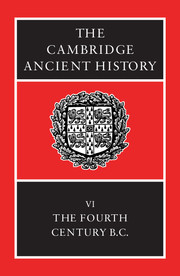Book contents
- Frontmatter
- 1 Sources and their uses
- 2 Sparta as victor
- 3 Persia
- 4 The Corinthian War
- 5 Sicily, 413–368 B.C.
- 6 The King's Peace and the Second Athenian Confederacy
- 7 Thebes in the 360s B.C.
- 8 Regional surveys I: Persian lands and neighbours
- 9 Regional surveys II: the West and North
- 10 Society and economy
- 11 The polis and the alternatives
- 12 Greek culture and science
- 12a The Growth of Schools and the Advance of Knowledge
- 12b Medicine
- 12c Greek art: Classical to Hellenistic
- 12d Greek agriculture in the classical period
- 12e Warfare
- 13 Dion and Timoleon
- 14 Macedon and north-west Greece
- 15 Macedonian hegemony created
- 16 Alexander the Great Part 1: The events of the reign
- 17 Alexander the Great Part 2: Greece and the conquered territories
- 18 Epilogue
- Chronological Table
- BIBLIOGRAPHY
- Index
- Map 1: Greece and Western Asia Minor
- Map 9: Egypt
- Map 20: Alexanders campaigns
- References
12b - Medicine
from 12 - Greek culture and science
Published online by Cambridge University Press: 28 March 2008
- Frontmatter
- 1 Sources and their uses
- 2 Sparta as victor
- 3 Persia
- 4 The Corinthian War
- 5 Sicily, 413–368 B.C.
- 6 The King's Peace and the Second Athenian Confederacy
- 7 Thebes in the 360s B.C.
- 8 Regional surveys I: Persian lands and neighbours
- 9 Regional surveys II: the West and North
- 10 Society and economy
- 11 The polis and the alternatives
- 12 Greek culture and science
- 12a The Growth of Schools and the Advance of Knowledge
- 12b Medicine
- 12c Greek art: Classical to Hellenistic
- 12d Greek agriculture in the classical period
- 12e Warfare
- 13 Dion and Timoleon
- 14 Macedon and north-west Greece
- 15 Macedonian hegemony created
- 16 Alexander the Great Part 1: The events of the reign
- 17 Alexander the Great Part 2: Greece and the conquered territories
- 18 Epilogue
- Chronological Table
- BIBLIOGRAPHY
- Index
- Map 1: Greece and Western Asia Minor
- Map 9: Egypt
- Map 20: Alexanders campaigns
- References
Summary
The sources available for the reconstruction of the exciting developments that took place in Greek medical thought and practice in the late fifth and fourth centuries B.C. are extensive, although in places defective and in places biased. They fall into three main categories, first the extant treatises of the Hippocratic Corpus, second other literary sources, and third the inscriptional evidence, and a summary analysis of each in turn will serve to illustrate both the range and the limitations of the information they provide.
The great majority of the sixty or so treatises in the so-called Hippocratic Corpus date from the later part of the fifth or from the fourth century. The main exceptions are a handful of works, such as On Nutriment, On Sevens and some of the treatises on medical ethics, that show Stoic or Epicurean influence, and one, On the Heart, that is generally thought to be approximately contemporary with the work of the Alexandrian biologists Herophilus and Erasistratus. Even when we discount these few later works, the variety within the Hippocratic Corpus is very great, and the treatises – all of them anonymous – are evidently the work of many different authors representing, in some cases, radically divergent shades of opinion. Whether Hippocrates himself was responsible for any of them is controversial. Although Hippocrates is occasionally referred to in contemporary or near contemporary writers, notably Plato, Aristotle and Aristotle's pupil Meno, the medical historian whose work is excerpted in the papyrus Anonymus Londinensis, they provide only very limited, and in places conflicting, evidence concerning the medical theories and practices he upheld, though they confirm the admiration and respect in which he was held already in the fourth century.
- Type
- Chapter
- Information
- The Cambridge Ancient History , pp. 634 - 646Publisher: Cambridge University PressPrint publication year: 1994

